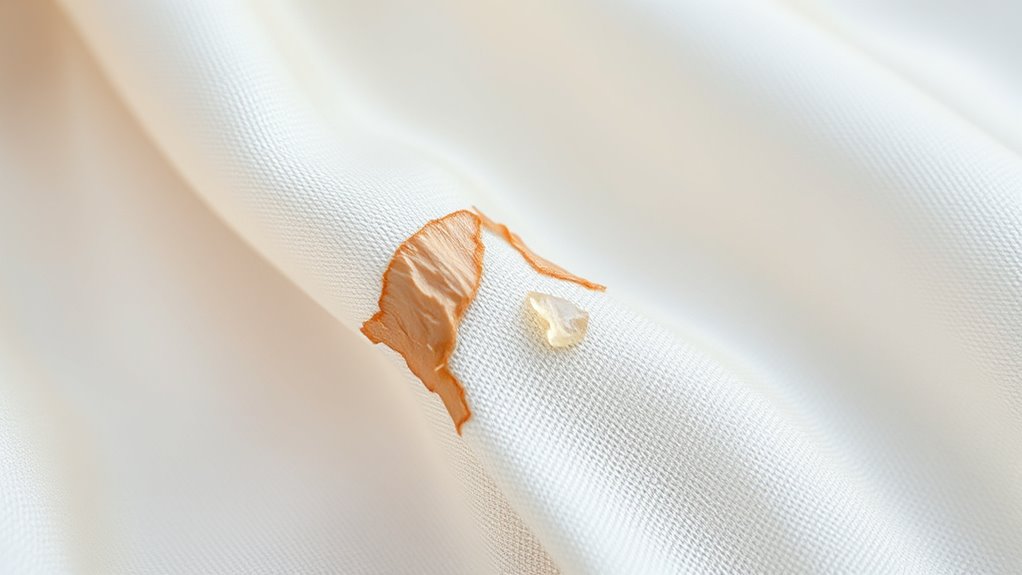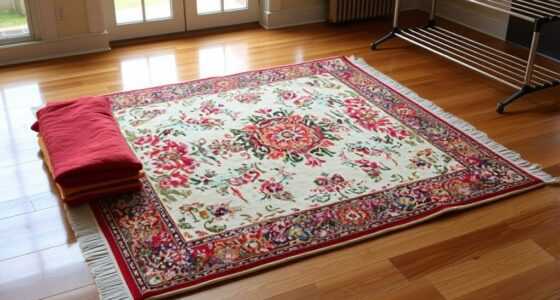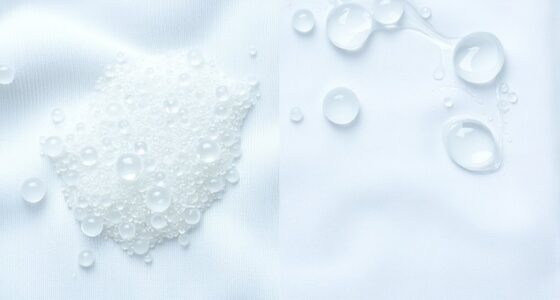Using the wrong cleaner can seriously damage silk by disrupting its delicate fiber structure and upsetting its natural pH balance. Harsh alkaline or acidic products weaken the fibers, cause fading, and dullness, and can lead to brittleness or tears. When you choose products not suited for silk, you risk irreversible harm that shortens its lifespan. Keep in mind, understanding how pH levels affect silk helps you protect your fabric—discover more about maintaining silk’s beauty and durability.
Key Takeaways
- Incorrect cleaners with unsuitable pH levels weaken silk fibers, leading to damage, dullness, and reduced durability.
- pH imbalance from wrong products disrupts the fiber’s crystalline and amorphous structure, causing fiber degradation.
- Alkaline or acidic cleaners break down fibroin proteins, resulting in brittleness and compromised fiber strength.
- Using improper pH cleaners can cause uneven dye absorption, fading, and loss of silk’s natural luster.
- Proper pH-balanced products preserve fiber integrity, preventing odor retention and extending silk’s lifespan.
Understanding Ph Levels and Their Impact on Silk

Understanding pH levels is essential when working with silk because it directly affects the fiber’s properties and longevity. Maintaining proper pH balance is vital in textile chemistry, as silk fibers are sensitive to pH fluctuations. If the pH is too acidic or alkaline, it can weaken the fiber structure, causing damage or loss of luster. When you handle silk, using products with the correct pH ensures you preserve its natural strength and softness. Proper pH levels during cleaning or processing are crucial to prevent damage to the delicate fibers. Poor pH control during cleaning or processing can lead to irreversible damage, making the fabric brittle or dull. Additionally, understanding the chemical properties of silk helps in selecting appropriate cleaning agents that do not compromise its integrity. By understanding the importance of pH balance, you can prevent deterioration and extend the life of silk textiles, ensuring they stay beautiful and durable over time.
The Science Behind Silk Fiber Structure
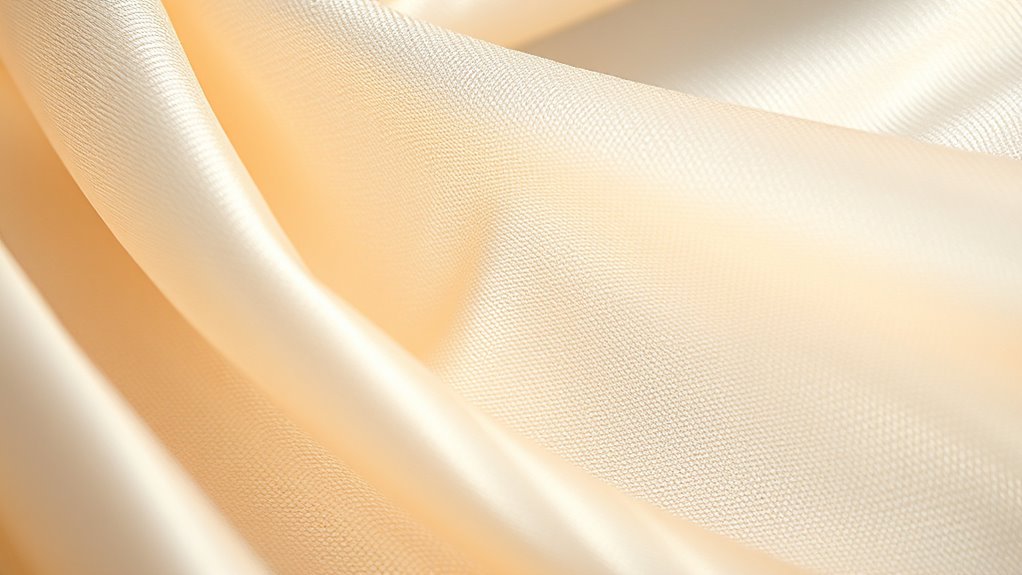
Silk’s unique properties stem from its complex fiber structure, which combines strength, flexibility, and luster. This structure consists of fibroin proteins arranged in a crystalline and amorphous pattern, giving silk its remarkable fiber tensile strength. During silk dyeing, the fiber’s molecular makeup influences how dyes bond, affecting color vibrancy and longevity. The crystalline regions provide rigidity, while the amorphous areas allow for flexibility, making silk both durable and soft. The tight packing of fibroin fibers underpins its tensile strength, enabling silk to stretch without breaking. Additionally, the self-assembling nature of fibroin molecules contributes to the fiber’s stability and resilience. Understanding this intricate fiber architecture explains why silk maintains its elegance and resilience, even after dyeing or washing. The fiber’s molecular structure plays a crucial role in how silk responds to environmental factors, ensuring its continued beauty. Preserving the fiber’s structure is essential for maintaining silk’s natural beauty and durability. Recognizing how the fiber’s molecular composition influences dye affinity can help in selecting appropriate cleaning methods that prevent damage. Furthermore, the fiber’s crystalline and amorphous regions determine its interaction with various cleaning agents, making gentle methods vital for preservation. Proper understanding of the fiber’s molecular interactions can also aid in developing gentle cleaning techniques that protect silk’s delicate architecture.
How Acidic and Alkaline Cleaners Affect Silk Integrity
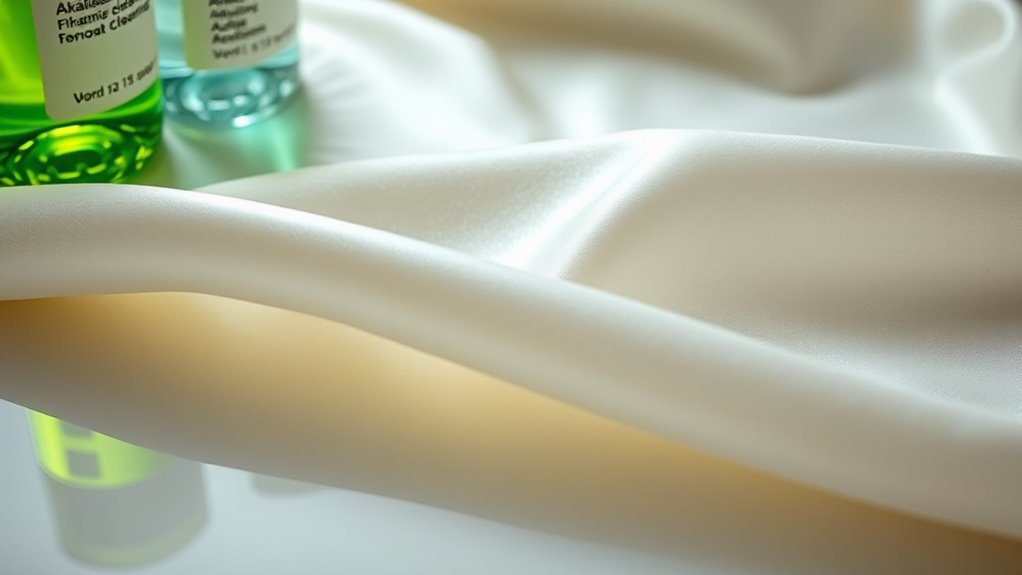
Acidic and alkaline cleaners can considerably compromise silk’s delicate fiber structure if not used properly. During silk dyeing, the pH environment is essential; extreme pH levels can cause color fading or uneven dye absorption. Alkaline cleaners may weaken fibers, leading to loss of luster and durability, especially in silk weaving where the fabric’s strength is critical. Conversely, overly acidic solutions can damage the protein structure, resulting in brittleness and tears. Proper pH balance preserves silk’s natural sheen and structural integrity. When cleaning silk, avoid harsh cleaners that disrupt the fiber’s delicate balance, as this can ruin both the fabric’s appearance and its longevity. Knowing how pH influences silk helps you select the right cleaning methods to maintain its beauty. Additionally, understanding the impact of fiber structure on silk’s resilience can guide more effective and gentle cleaning practices. Recognizing the importance of fabric preservation techniques can further extend the lifespan of silk garments. Maintaining an appropriate pH level is essential to prevent fiber damage and ensure the longevity of silk textiles. Being aware of pH levels in cleaning products can help prevent unintended damage during maintenance.
Common Cleaning Agents That Harm Silk

Certain cleaning agents can severely damage silk if you’re not careful. Many household detergents contain harsh chemicals that can strip silk’s natural luster and weaken its fibers. These cleaners often have high detergent effectiveness but are not suitable for delicate fabrics like silk. Using them too frequently worsens the damage, causing fading, stiffness, or even tearing. Avoid bleach, ammonia, and strong degreasers, as they can break down silk’s proteins. Even some gentle detergents may harm silk if used excessively or at the wrong pH level. To preserve silk’s beauty and integrity, opt for pH-balanced, silk-specific cleaners and limit cleaning frequency. Proper calibration of cleaning agents ensures optimal color accuracy can help prevent deterioration and maintain the fabric’s softness and sheen over time. Regular maintenance and proper cleaning monitoring air quality indicators can also help prolong the fabric’s lifespan and keep it looking its best. Additionally, understanding the fiber science behind silk can guide better cleaning practices to avoid unintended damage, especially considering the importance of payment processing security in maintaining overall quality standards. Properly understanding pH levels in cleaning products is essential for safeguarding silk fibers and ensuring safe cleaning routines.
Signs of Damage Caused by Wrong Cleaning Products
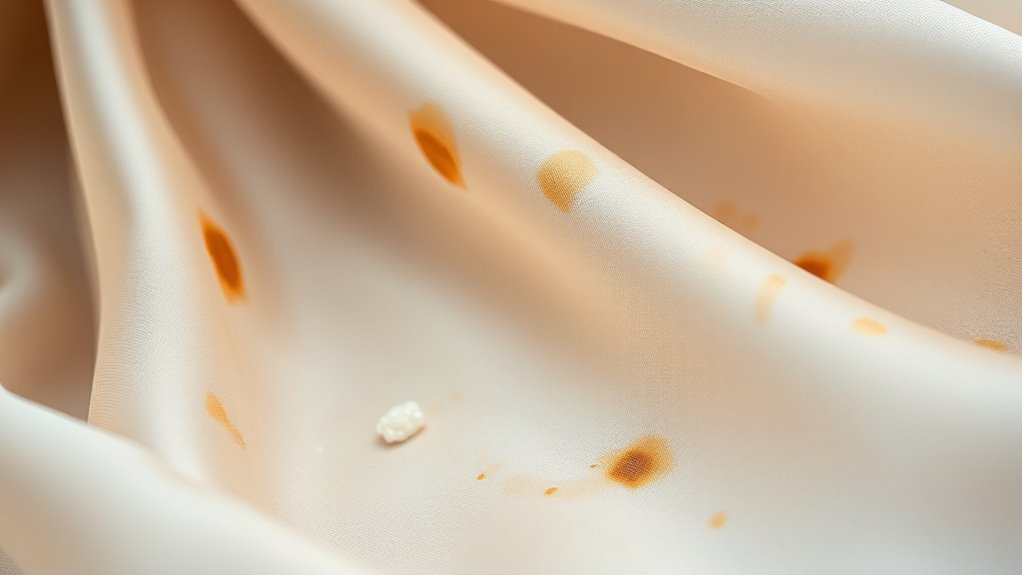
Using the wrong cleaning products can cause visible damage to your fabrics. You might notice discoloration, fading, or weakened fibers over time. Persistent odors can also linger, signaling that your cleaning choices aren’t ideal. Additionally, improper cleaning solutions can compromise the fabric’s material integrity, leading to further deterioration. Employing the right cleaning methods can preserve the fabric’s longevity and appearance.
Discoloration and Fading
Discoloration and fading often signal that the wrong cleaning products have been used on your fabrics or fibers. When improper cleaners are applied, they can disturb the dye stability, leading to uneven color fading. This damage affects the fabric’s appearance, making it look dull or patchy. You might notice that vibrant colors lose their brightness or that dark shades appear blotchy. Such signs indicate that the cleaning agent has compromised the dye’s bonds, causing the pigment to break down or wash out. To prevent this, choose pH-balanced cleaners designed for delicate fibers like silk. Proper products help maintain dye stability, ensuring your fabrics retain their original color and luster over time. Recognizing these signs early can save your fabrics from irreversible damage.
Fabric Weakening Signs
When fabrics are exposed to improper cleaning products, their structural integrity can suffer, revealing signs of damage. Chemical reactions between harsh cleaners and fibers can weaken the fabric over time. You might notice areas that feel thinner or more fragile, indicating fiber degradation. The fabric may become more susceptible to tears or holes, even with minimal stress. Colors can fade unevenly as fibers break down, and the texture may change—becoming rough or stiff. These signs point to compromised fibers that are no longer holding together well. Recognizing these weakening signs helps you understand that the wrong cleaning products accelerate fiber degradation, ultimately shortening the lifespan of your fabric. Protect your investments by choosing appropriate cleaners to maintain fabric strength and durability.
Persistent Odors
Persistent odors lingering in fabrics are often a clear sign that improper cleaning products have damaged the fibers. When pH testing reveals an imbalance, it indicates the cleaning solution may have been too acidic or alkaline, harming the fabric’s structure. This damage creates pockets where odors can trap, making them stubborn to remove. Frequent cleaning with the wrong products can accelerate fiber degradation, worsening odor retention over time. To prevent this, adjust your cleaning frequency based on fabric type and guarantee you use pH-balanced cleaners suited for silk and fine fibers. Regularly testing the pH level helps you choose the right cleaning agents, preserving fiber integrity and eliminating odors effectively. Proper pH management protects your fabrics from long-term damage and persistent smells.
Choosing Ph-Balanced Cleaners for Silk Care
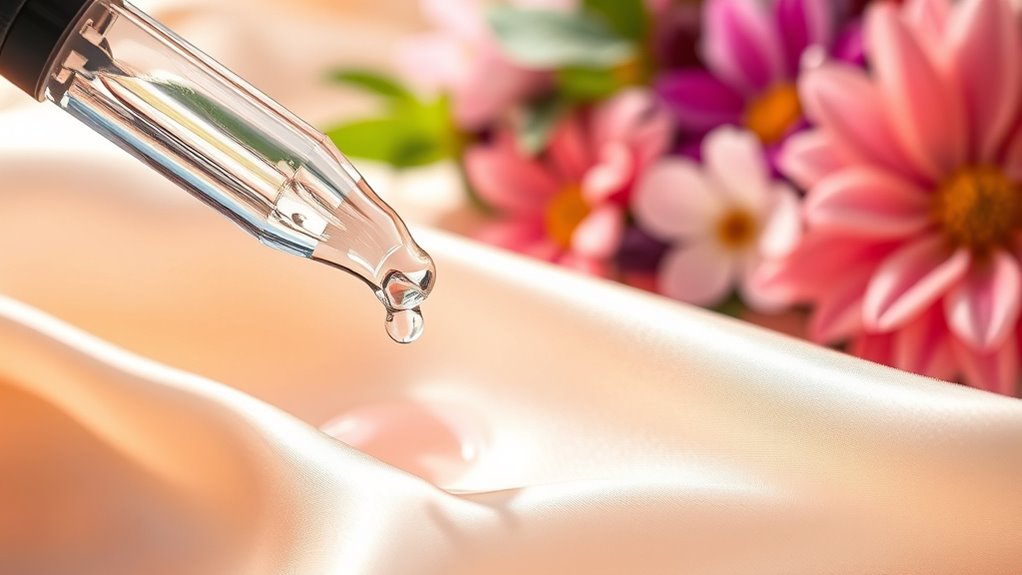
Choosing a pH-balanced cleaner is essential for maintaining the delicate fibers of silk. When selecting detergent ingredients, look for gentle formulas specifically designed for silk or delicate fabrics. These cleaners help preserve the fiber’s natural luster and strength. Keep in mind that cleaning frequency also matters; over-washing can damage silk, so wash only when necessary. To ensure ideal care:
- Opt for mild, pH-balanced detergents free from harsh chemicals
- Avoid alkaline or acidic cleaners that can weaken silk fibers
- Use minimal detergent to prevent residue buildup and fiber degradation
Tips for Properly Maintaining and Preserving Silk Fabrics
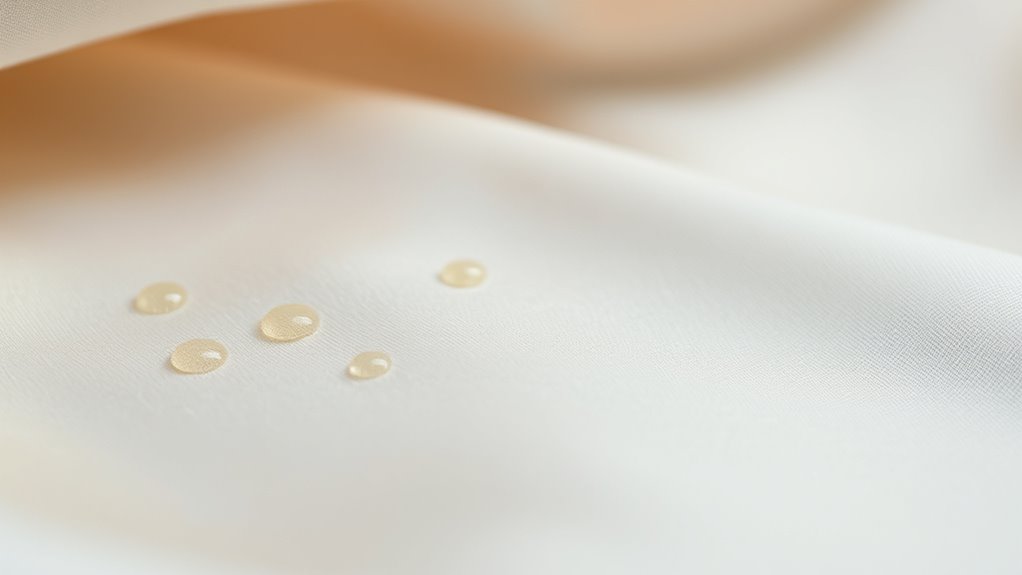
To keep your silk fabrics looking their best, it is crucial to handle them with care and follow proper maintenance practices. When caring for silk, avoid harsh detergents that can damage the delicate fibers from silk dyeing or silk weaving. Always wash silk in cool, pH-balanced water, and opt for gentle hand washing or a delicate cycle if using a machine. Store silk garments in a cool, dry place, away from direct sunlight, to prevent fading and deterioration. Regularly inspect your silk for signs of wear or stain buildup, and treat spots immediately with a mild, pH-neutral cleaner. Proper handling and cleaning techniques help preserve the vibrant colors from silk dyeing and maintain the integrity of the woven fibers, prolonging the life of your silk fabrics.
Frequently Asked Questions
Can Natural or Homemade Cleaners Be Safe for Silk?
You might think DIY solutions are safe for silk, but they can pose chemical risks that damage delicate fibers. Homemade cleaners often lack the precise pH balance silk needs, potentially causing discoloration or weakening. Instead, stick to gentle, silk-specific detergents to protect your fabric. While natural ingredients sound safe, they may still harm silk if not properly formulated. Always choose products designed for silk to avoid costly damage.
How Often Should Silk Be Cleaned Without Damage?
You should clean silk sparingly, about once every 4-6 wears or when visibly dirty, to prevent damage. Use gentle detergents with a proper pH balance to protect the delicate fibers. Avoid harsh chemicals, and always hand wash or use a gentle cycle if machine washing. This careful approach helps maintain the silk’s softness, shine, and integrity, ensuring your garment stays beautiful and undamaged over time.
Are There Specific Brands Recommended for Silk-Safe Cleaners?
It might seem like finding the perfect silk-safe cleaner is a coincidence, but it’s really about choosing products designed for delicate fabrics. For silk stain removal and gentle cleaning techniques, look for brands that specify their products are safe for silk. Trusted names often include those with gentle, pH-balanced formulas. Always check labels and do a patch test to guarantee your silk remains pristine and damage-free.
Does Washing Silk With Other Fabrics Increase Damage Risk?
Washing silk with other fabrics can increase damage risk because of fabric compatibility issues. Different textiles have varying textures and cleaning needs, so mixing delicate silk with rougher or heavier materials may cause abrasion or stretching. To protect your silk, limit cleaning frequency and wash it separately or with compatible fabrics. This approach helps maintain its luster and integrity, ensuring your silk stays beautiful and damage-free for longer.
What Long-Term Effects Can Improper Cleaning Have on Silk?
Imagine the silent threat lurking with improper cleaning—chemical residue and fiber degradation. Over time, these unseen enemies weaken silk’s delicate fibers, causing it to lose its luster and strength. You might not notice initially, but repeated mishandling accelerates deterioration, leading to irreversible damage. Without proper care, your silk could become brittle, faded, and ultimately ruined, revealing a tragic loss of beauty and value you once cherished.
Conclusion
Using the wrong cleaner can seriously damage your silk, just like it did for Lisa’s cherished scarf that turned stiff and dull after a harsh detergent. By choosing pH-balanced products and handling silk carefully, you protect its delicate fibers and preserve its beauty. Remember, a small mistake can ruin something valuable—so always prioritize gentle, silk-friendly cleaning methods. Your silk deserves the right care to stay stunning for years to come.
